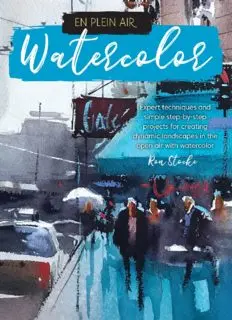
En Plein Air: Watercolor: Expert Techniques and Simple Step-by-Step Projects for Creating Dynamic Landscapes in the Open Air with Watercolor PDF
Preview En Plein Air: Watercolor: Expert Techniques and Simple Step-by-Step Projects for Creating Dynamic Landscapes in the Open Air with Watercolor
EN PLEIN AIR Watercolor Expert techniques and simple step-by-step projects for creating dynamic landscapes in the open air with watercolor Ran Stocke No One Home for the Holidays Seattle Art Museum at Night Contents Drawing Drawing Philosophy Drawing Styles Perspective & Architecture Drawing Figures Painting on Location Getting Started Equipment Setting Up Adapting to the Conditions Painting from Photographs Brushes Paint King Street Station Step-by-Step Composition & Tension Placing Your Subject Simple Shapes Tension Color & Value The Color Wheel Color Washes Color vs. Gray Color Swatches Nice Marina Step-by-Step Tips & Techniques Developing Techniques Shadows Reflections Perspective Breaking Tension Detail The Artist’s Voice Define Your Voice Intersection in Prague Step-by-Step Individual Style Sketchbook to Studio Sketching Sketchbooks Interiors Hotel Negresco Step-by-Step About the Author Drawing English Village Reflections Drawing Philosophy Draw all you want, but paint only what you need. Drawing is the foundation of your paintings. It is the act of observing your three-dimensional subject, and then trying to visually recreate it on a two- dimensional plane using shape, value, and perspective. It is the one thing that can derail your painting from the start, and it is perhaps the most important exercise you will take from this book. I discuss drawing on almost every page —reinforcing the old saying, “You can’t hide a bad drawing with a good painting.” In this section, I will show you a few pieces to the puzzle that have helped me see drawing as part of the painting, rather than a hurdle I need to overcome before I put brush to paper. There is one rule in painting that I have learned to be especially true: “If you want to learn to paint, learn to draw.” I am simply carrying on a tradition from the many artists who came before me, particularly those whom I admire and have given me this sage advice. Drawing is one element that I’m always working on. I consider my sketchbook to be my most valuable tool. The work you do today in your sketchbook will pay dividends later in your finished work. In today’s busy world, it is often difficult to find time to complete a painting every day; it’s easier to open up your sketchbook and do a quick thumbnail drawing or value study. Spend your time drawing different subjects in different styles and with different media. Learn the fundamentals of basic perspective and how to see your subject well enough that you can recreate its likeness in a sketch. Remember, these are your lines, and they can never be duplicated; and if they originate from a strong foundation, they can never be challenged. This will soon become one of your favorite pastimes. As you develop your ability, you are also developing your artistic fingerprint. This, to me, is perhaps the best reason to be a creative person and should give you the permission to draw your own way. It’s what inspires me every time I go to my easel. Madrid Fountain Drawing Styles There are many drawing styles to practice—crosshatching, pointillism, scribbles, etc. My preferred technique is a modified contour drawing. I call this a “controlled scribble.” Contour drawing is a technique in which you draw your subject with one continuous line without lifting the pencil from the surface of the paper. This technique is a wonderful way to help soften edges, loosen up, and connect your shapes. In most of my work, my first concern is connecting shapes. With contour drawing you can achieve this easily—it just takes practice. Start by making a simple shape, say a circle. Now keep your pencil moving and don’t lift it off the paper. Move to the side of the circle and draw a square, the whole time never lifting your pencil from the surface. Think of it as a controlled scribble. What you have done is draw two shapes with a connected the pencil line—but more importantly, you have connected the two shapes in your mind. So when you paint them, you won’t hesitate to connect them with a brushstroke, a wash, or by some other means. The reason connecting shapes is so vital in watercolor is because, unlike other media, it is very easy to get caught up in the work and accidentally establish unattended hard edges. This is known as tension. Most artists tend to paint all of their shapes separately, but this can be the kiss of death in watercolor. By connecting these shapes in your drawing, you’ve created a path to paint.
